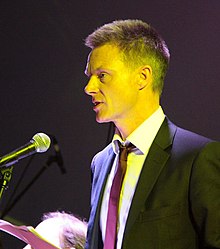
Tate is an institution that houses, in a network of four art galleries, the United Kingdom's national collection of British art, and international modern and contemporary art. It is not a government institution, but its main sponsor is the UK Department for Culture, Media and Sport.

Patrick Joseph Caulfield,, was an English painter and printmaker known for his bold canvases, which often incorporated elements of photorealism within a pared-down scene. Examples of his work are Pottery and Still Life Ingredients.

Chelsea College of Arts is a constituent college of the University of the Arts London based in London, United Kingdom, and is a leading British art and design institution with an international reputation.

Wilhelm Lehmbruck was a German sculptor. One of the most important of his generation, he was influenced by realism and expressionism.

The Hon. Sir Nicholas Andrew Serota is a British art historian and curator.
Sir Charles Robert Saumarez Smith is a British cultural historian specialising in the history of art, design and architecture. He was the Secretary and Chief Executive of the Royal Academy of Arts in London from 2007 until he stepped down in 2018. He was replaced by Axel Rϋger, who took up the position in 2019.

Sir Alan Bowness CBE was a British art historian, art critic, and museum director. He was the director of the Tate Gallery between 1980 and 1988.

Shirazeh Houshiary is an Iranian-born English sculptor, installation artist, and painter. She lives and works in London.
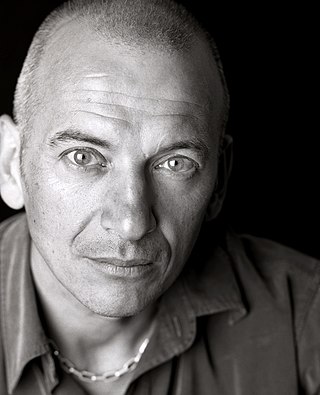
Phil Grabsky is a BAFTA-winning British documentary filmmaker who has received multiple awards for his directing, writing, producing and cinematography.

Tate Britain, known from 1897 to 1932 as the National Gallery of British Art and from 1932 to 2000 as the Tate Gallery, is an art museum on Millbank in the City of Westminster in London, England. It is part of the Tate network of galleries in England, with Tate Modern, Tate Liverpool and Tate St Ives. It houses a substantial collection of the art of the United Kingdom since Tudor times, and in particular has large holdings of the works of J. M. W. Turner, who bequeathed all his own collection to the nation. It is one of the largest museums in the country. The museum had 525,144 visitors in 2021, an increase of 34 percent from 2020 but still well below pre- COVID-19 pandemic levels. In 2021 it ranked 50th on the list of most-visited art museums in the world.
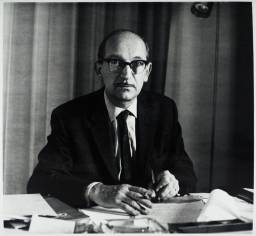
Sir Norman Robert Reid was an arts administrator and painter. He served as the Director of the Tate Gallery from 1964 to 1979.
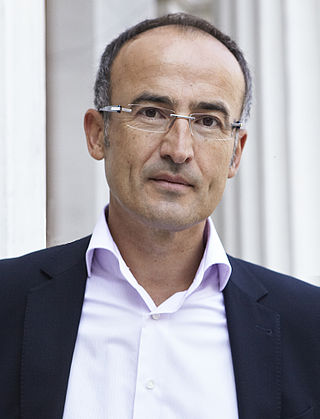
Tobias G. Natter is an Austrian art historian and internationally renowned art expert with a particular expertise in "Vienna 1900".
Stephen Farthing is an English painter and writer of art history.
Lubaina Himid is a British artist and curator. She is a professor of contemporary art at the University of Central Lancashire. Her art focuses on themes of cultural history and reclaiming identities.

Marlborough Fine Art was founded in London in 1946 by Frank Lloyd and Harry Fischer. In 1963, a gallery was opened as Marlborough-Gerson in Manhattan, New York, at the Fuller Building on Madison Avenue and 57th Street, which later relocated in 1971 to its present location, 40 West 57th Street. The gallery operates another New York space on West 25th Street, which opened in 2007. It briefly opened a Lower East Side space on Broome Street.
The year 2012 in art involves some significant events.

Modern sculpture is generally considered to have begun with the work of Auguste Rodin, who is seen as the progenitor of modern sculpture. While Rodin did not set out to rebel against the past, he created a new way of building his works. He "dissolved the hard outline of contemporary Neo-Greek academicism, and thereby created a vital synthesis of opacity and transparency, volume and void". Along with a few other artists in the late 19th century who experimented with new artistic visions in sculpture like Edgar Degas and Paul Gauguin, Rodin invented a radical new approach in the creation of sculpture. Modern sculpture, along with all modern art, "arose as part of Western society's attempt to come to terms with the urban, industrial and secular society that emerged during the nineteenth century".
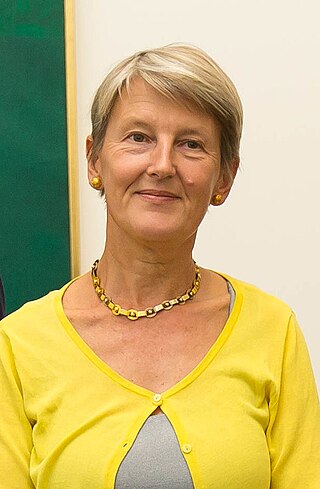
Penelope Curtis is a British art historian and curator. Fom 2015 to 2020 she was the director of Lisbon's Museu Calouste Gulbenkian, and from 2010 to 2015 director of Tate Britain. She is the author of several monographs on sculpture and has written widely at the invitation of contemporary artists.
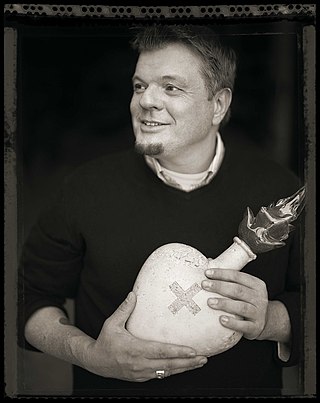
Tim Tate is an American artist and the co-founder of the Washington Glass School in the Greater Washington, DC capital area. The school was founded in 2001 and is now the second largest warm glass school in the United States. Tate was diagnosed as HIV positive in 1989 and was told that he had a year left to live. As a result, Tate decided to begin working with glass in order to leave a legacy behind. Over a decade ago, Tate began incorporating video and embedded electronics into his glass sculptures, thus becoming one of the first artists to migrate and integrate the relatively new form of video art into sculptural works. In 2019 he was selected to represent the United States at the sixth edition of the GLASSTRESS exhibition at the Venice Biennale.

Ai-Da is a robotic art exhibition created by British artist Aidan Meller, which has been described by its creator as "the world's first ultra-realistic humanoid robot". Completed in 2019, Ai-Da is an android incorporating computer graphics and artificial intelligence algorithms that makes drawings, paintings, and sculptures. It is named after Ada Lovelace.
